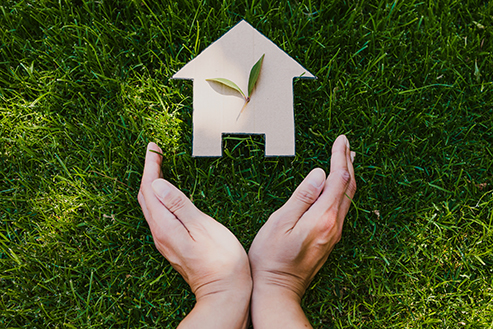
Blog
We keep you up to date on the most recent real estate news and events.
The Rise of Sustainable Real Estate: Why Eco-Friendly Living is More Than a Trend
Imagine waking up to the soft glow of natural sunlight streaming through energy-efficient windows, surrounded by lush greenery that purifies the air around your home. The concept of sustainable living, once a niche preference, is now shaping the future of the real estate industry, particularly in India. With the growing awareness of climate change and increasing urbanization, sustainable real estate is not just a passing trend but a necessary evolution. So, what exactly is driving this shift towards eco-friendly living, and why should homebuyers and investors take notice?
The Growing Demand for Sustainable Real Estate
The real estate sector contributes significantly to global carbon emissions, accounting for about 39% of total energy-related CO2 emissions. In India, the scenario is similar, with urban areas expanding rapidly and increasing the environmental burden. As cities grow, the need for sustainable infrastructure becomes more apparent. Sustainable buildings, also known as "green buildings," are designed to minimize environmental impacts by using resources more efficiently. These structures incorporate elements like energy-saving appliances, efficient water management systems, and sustainable construction materials.
A study by the Indian Green Building Council (IGBC) predicts that India’s green building market is set to double by 2025, reaching approximately 10 billion square feet. With metro cities like Bengaluru and Delhi-NCR at the forefront, this growth reflects the increasing demand from consumers for eco-friendly homes that offer long-term cost savings and a healthier living environment.
Key Drivers of Sustainable Real Estate in India
- Consumer Awareness and Preferences Homebuyers today are more informed and environmentally conscious. According to a survey by CBRE, around 78% of Indian homebuyers consider environmental impact and energy efficiency as key factors in their purchasing decisions. This shift is driven by increased awareness of climate change and the desire to live in homes that align with sustainable values. Residents prefer green-certified buildings as they ensure better air quality, lower utility costs, and overall well-being.
- Government Initiatives and Regulations The Indian government has been proactive in promoting sustainable construction. Regulations like the Energy Conservation Building Code (ECBC) and incentives for green building certifications, such as LEED (Leadership in Energy and Environmental Design) and GRIHA (Green Rating for Integrated Habitat Assessment), have played a crucial role in encouraging developers to adopt sustainable practices. These certifications set benchmarks for energy efficiency, water conservation, and reduced carbon footprints, helping standardize green building practices across the country.
Additionally, policies like the Pradhan Mantri Awas Yojana (PMAY) have included components to encourage sustainable and affordable housing, making eco-friendly homes more accessible to a broader population.
The Benefits of Sustainable Real Estate
- Cost Savings One of the primary benefits of sustainable real estate is its potential for cost savings. Although green buildings may have higher initial construction costs (estimated to be around 5-10% more), the long-term savings far outweigh these expenses. Energy-efficient appliances, solar panels, and water recycling systems help reduce utility bills by up to 30%. This is particularly beneficial in urban areas where energy costs are high. A study by KPMG highlighted that green buildings in India report a 20-25% reduction in operating costs, enhancing their appeal to both developers and occupants.
- Enhanced Property Value and ROI Eco-friendly buildings often command higher resale values and rental incomes. According to a report by JLL India, green-certified buildings can fetch up to 20% higher rents compared to non-certified ones. Investors are increasingly recognizing the long-term financial benefits of sustainable properties, as these assets tend to have lower vacancy rates and higher tenant retention. The trend is driven by the growing preference of tenants for healthier living environments and energy-efficient spaces that reduce their living expenses.
- Health and Well-being Sustainable buildings focus on enhancing indoor air quality, natural lighting, and overall comfort. Features like non-toxic paints, proper ventilation, and ample green spaces contribute to the well-being of occupants. With indoor pollution being a significant health concern in urban India, these attributes are becoming major selling points. The use of biophilic design principles, which incorporate natural elements into the built environment, has been shown to reduce stress and improve productivity, making sustainable homes a healthier choice for families.
Sustainable Construction Practices
- Energy Efficiency Incorporating energy-efficient designs is a cornerstone of sustainable construction. This includes using high-performance insulation, LED lighting, and smart home systems that monitor and optimize energy use. The integration of renewable energy sources like solar panels can reduce dependence on non-renewable power, significantly lowering carbon footprints. For example, installing a rooftop solar system can cut down electricity bills by 40-50%, providing a strong financial incentive for homeowners.
- Water Conservation Water scarcity is a pressing issue in many Indian cities. Sustainable buildings address this by employing water-saving fixtures, rainwater harvesting systems, and greywater recycling. These measures help reduce water consumption by up to 50%, as per data from the Indian Ministry of Environment, Forest, and Climate Change. Developers are increasingly incorporating these features into residential projects to meet the growing demand for water-efficient homes.
- Use of Sustainable Materials The choice of building materials plays a critical role in sustainability. The use of recycled, locally sourced, and eco-friendly materials reduces the environmental impact of construction. For instance, using fly ash bricks, bamboo, and recycled steel can lower the carbon footprint of a building by up to 30%. Additionally, sustainable materials are often more durable, reducing the need for frequent repairs and replacements.
Challenges and the Road Ahead
Despite its advantages, sustainable real estate faces several challenges in India. High initial costs and a lack of awareness among some developers can be barriers to adoption. Additionally, the fragmented nature of the real estate market and varying regulatory frameworks across states make standardization difficult. However, the growing demand for green buildings, supported by government policies and incentives, is slowly overcoming these obstacles.
Investors are also playing a key role in driving this change. With the rise of Environmental, Social, and Governance (ESG) investing, there is increasing pressure on real estate developers to adopt sustainable practices. ESG considerations are becoming a major factor for institutional investors, pushing the industry towards greener, more resilient buildings.
Conclusion: Embracing the Green Future
The rise of sustainable real estate in India is more than just a trend; it's a response to the urgent need for climate action and a shift towards more responsible living. For homebuyers, opting for a green-certified property is an investment in a healthier lifestyle and future financial savings. For developers, it’s an opportunity to lead the market with innovative solutions that meet the growing demand for eco-friendly living spaces.
As we look ahead, the real estate sector's transformation towards sustainability is set to accelerate, driven by consumer demand, regulatory support, and investor interest. By embracing sustainable practices, the industry can play a crucial role in building a greener, more resilient future for India.
In summary, the push towards sustainable real estate is no longer optional but essential. It’s time for all stakeholders—homebuyers, investors, and developers—to come together in this green revolution and build a better, more sustainable future.
This approach aligns with the latest industry trends and government initiatives, offering a promising outlook for the future of green real estate in India.

